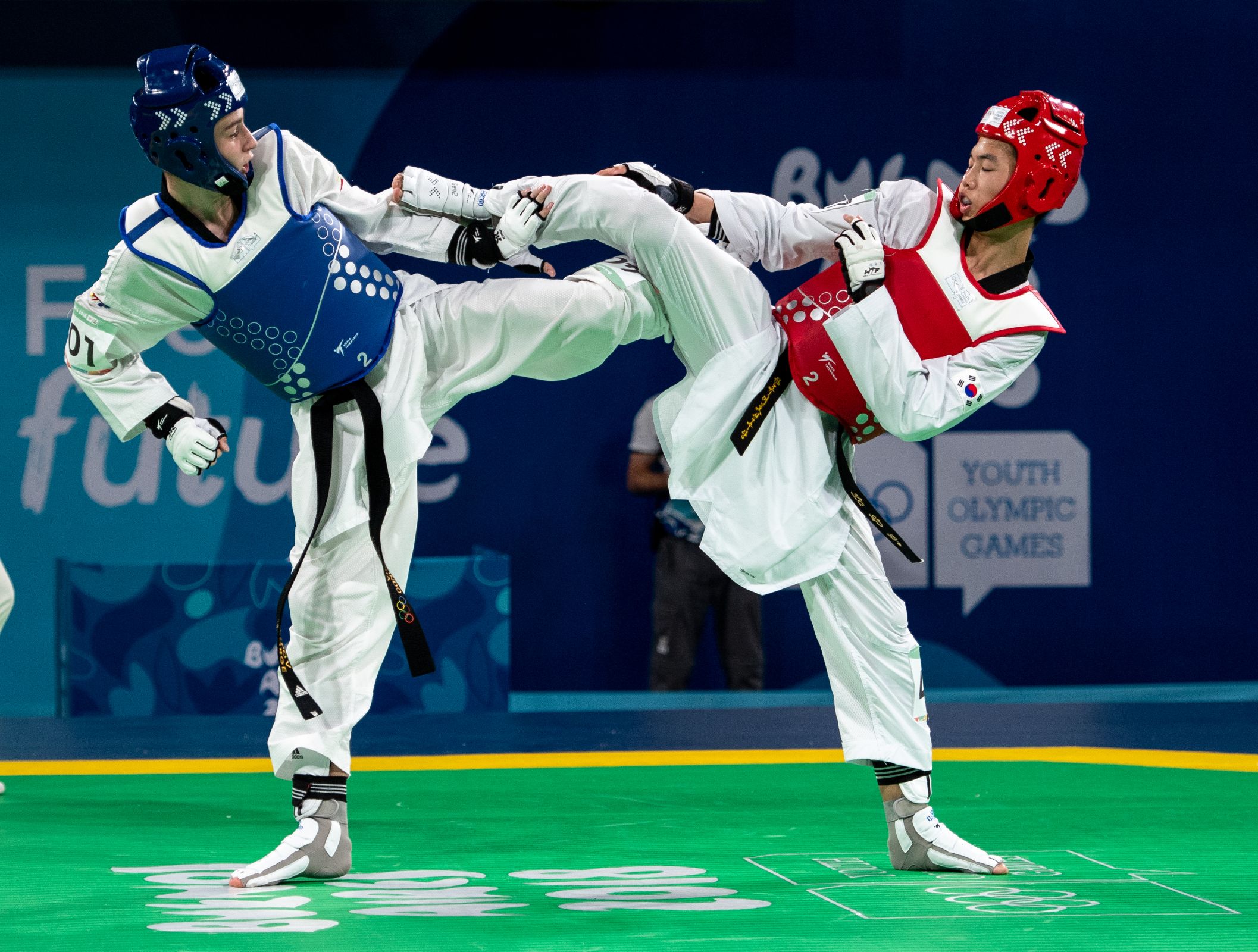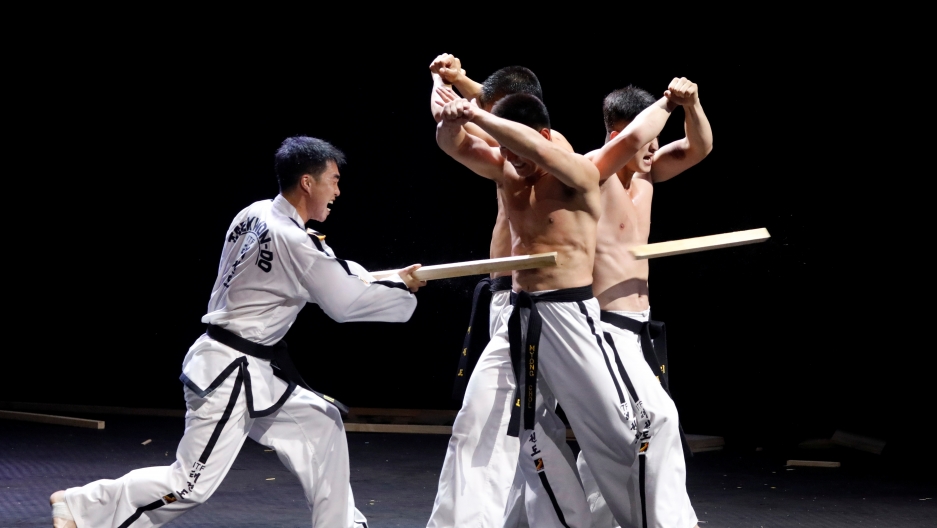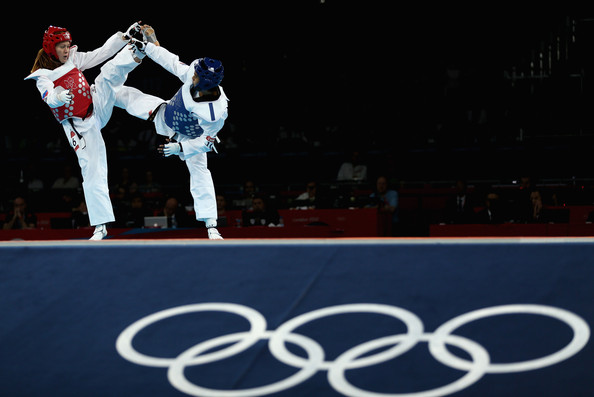Often people tend to confuse Karate and Taekwondo, while Karate has more punching the opponent, Taekwondo has more kicking features to get your opponent knocked down!
Martial art Taekwondo is a Korean based sport, which is one of the most popular martial art forms in the world, practiced in as many as 206 countries of the world. It is characterized by the head-height kicks, jumping and spinning kicks and fast kicks, and such other techniques. It is considered to be a deadly form of combat, and literally, the name indicates “the art of kicking and punching”. It was developed by Korean martial artists who had experience in Chinese martial arts, karate and other traditional Korean art forms such as Taekkyeon, Subak, and Gwonbeop. It gives emphasis on kicking, and the devastating power of the Taekwondo kick is known to have dropped the opponents in a few seconds.
This sport has been a part of the Olympic sport since 2000. The World Taekwondo competitions give additional points on strikes that have spinning kicks, head kicks etc. The most important characteristic of Taekwondo is its speed and agility. The theory of power advocated for taekwondo focuses on the following:
- Reaction force
- Concentration
- Equilibrium
- Breath control
- Mass of body
- Speed
Taekwondo Techniques
The organizations such as ITF or Kukkiwon on the general style of Taekwondo, while individual clubs, teachers or school can have tailor-made Taekwondo techniques.
The various techniques of Taekwondo include the following stances:
- Ready stance
- Walking stance
- Front stance
- Back stance
- T-stance
- Fighting stance
- Cat stance
- L-stance
- X-stance
- Fixed stance
- Bending stance
- Sitting stance
- Attention stance
- Closed stance
Even hand attacks have different techniques in taekwondo.
- Closed hand strikes
- Open hand techniques
The hand positions may be aplenty, varying from knife-hand, palm-heel, elbow strike, four-knuckle strike, eagle strike, tiger claw, pincer hand, scissor finger, chestnut fist, hammer fist, back fist, fore fist, etc.
The kick being the strongest and most striking feature of Taekwondo. Longer limbs give better access to kick down your opponents. It is a mode of self-defense and very apt to knock down the counterparty in a few seconds. The various kick forms in taekwondo include:
- Front kick
- Sidekick
- Roundhouse kick
- Back kick
- Reverse sidekick
- Hook Kick
- Axe kick
- Crescent kick
- Spin kick
- Fly Kick
- Jump Kick
- Advanced kick
- Fast Kick
Even various blocking techniques form a part of Taekwondo which is as follows:
- Single forearm block
- Low block
- Rising block
- Palm block
- Knife hand block
- Double forearm block
- Double knife hand block
- Nine block
- Upper block
The typical uniform for game is called a Dobok, which is generally a white or sometimes black colored dress with a belt tied at the waist. White is generally considered to be the traditional color and encouraged to be worn at the formal ceremonies like belt tests, promotions, etc. Colored uniforms are often reserved for special demonstration teams or high-level instructors. The Dobok has different styles of jacket, such as the cross-over front jacket, the cross-over Y-neck jacket and the pull-over V-neck jacket.
The belt represents the various levels of Taekwondo.
The belt ranks for taekwondo in order are as follows:
Junior belts: White Belt- 10th Gup, Yellow Stripe Belt- 9th Gup, Yellow belt- 8th Gup, Green Stripe Belt- 7th Gup.
Senior belts: Green Belt- 6th Gup, Blue Stripe Belt- 5th Gup, Blue Belt- 4th Gup, Red Stripe Belt- 3rd Gup, Red Belt- 2nd Gup, Black Stripe Belt- 1st Gup.
Black belts: 1st Dan Black Belt, 2nd Dan Black Belt, 3rd Dan Black Belt, 4th Dan Black Belt, 5t Dan Black Belt, 6th Dan Black Belt, 7th Dan Black Belt, 8th Dan Black Belt, 9th Dan Black Belt.
In order to advance from one rank to the other, students complete their promotion tests, where they demonstrate their proficiency in the various prospects of this martial art before a panel of judges.
Taekwondo in Olympics
Taekwondo forms a part of the Summer Olympics and made its first appearance as a demonstration sport in the 1988 Summer Olympics in Seoul, South Korea. It was included as an official sport for medal contention at the 2000 Sydney Games and Taekwondo is one of the two Asian martial arts included on the Olympic program.
The event for taekwondo is for both men and women which are conducted in four different weight classes. While for men, the categories are: -<58kg, <68kg, <80kg and >80kg; for women the divisions are <49kg, <57kg, <67kg, >67kg, classified as flyweight, featherweight, middleweight and heavyweight accordingly. The events involve a single elimination tournament to decide the gold and silver medallists. The two losing semi-finalists move for the bronze competition.
Iranian Hadi Saei, American Steven Lopez, along with Huang Chih-Hsiung of Chinese Taipei are the only three athletes who have medals in multiple weight classes. Hwang Kyung Seon had become the first woman ever to win three Olympic Taekwondo medals.
South Korea has been the most successful nation in Olympic Taekwondo, with 14 medals, where 10 are gold, 2 silver, and 2 bronze. Chinese Taipei, being the second most successful nation with 7 medals to their credit, of which 2 are gold, one silver, and four bronze.
The taekwondo tournament at the 2018 Summer Youth Olympics will take place between 6th to 18th October in Buenos Aires, Argentina, where 10 events considering 100 participants, 50 boys, and 50 girls, will take place.
Even at the 2018 Asian Games, held at Jakarta, Indonesia, Taekwondo was a part of the competition organized from 19th August to 23rd August 2018. South Korea topped the medal table with 5 golds, 5 silver, and 2 bronze medals, while Iran came second with a total of 7 medals that had 2 gold, 3 silver, and 2 bronze medals.
Also, Check:










